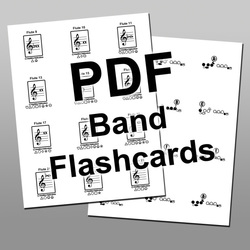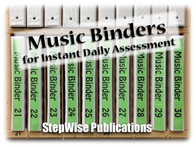 My job as a band/orchestra teacher has been a lot easier since I started using "Music Binders". Such a lovely, bland name, isn't it? I probably should call them "Secret Codebooks of Sonic Awesomeness" or something, but for now each binder has a printed spine (this year's color of card stock is lime green) that simply says "Music Binder ___" (a number between 1-43 goes in each space) slid into the clear plastic cover. Yep, they are pretty dang awesome! Materials & Costs Anyone who wants to use the system I am suggesting here will have to deal with a couple of logistical problems. First, you will need a rack or some other system for keeping the binders organized and accessible to the students as they enter your classroom each period. Second, you will need a small but hefty chunk of money to purchase the binders, sheet protectors, dry erase markers, and zipper pouches. I was personally able to use my killer carpentry skills to convert a couple of shelves into racks that perfectly accommodate up to 80 binders. I also used school textbook funds (with full disclosure to my principal) combined with band funds to purchase 50 white view binders from the district warehouse for $3 each, along with zipper pouches ($1 each), white board markers, and tons of sheet protectors from Wal-Mart for a grand total of less than $300. This is some of the best money I have EVER spent! 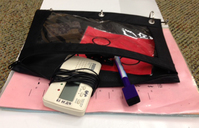 Filling and Using Music Binders Once all the prep work was done I had some students help me stuff all the WORKSHEETS in the sheet protectors and packed each binder with 8 or 9 double-sided pages. They also helped me slide in the blandly-named green spines I mentioned earlier. Now for the real "FUN"! (I put FUN in quotes, because the binders are not really fun for students...they are fun for me! However, they provide intensely motivating learning opportunities for students, which is a feeling similar to fun.) So, you've been reading and waiting to find out what in the heck I do with the binders. Well, I do primarily 6 things with them: 1. Take Roll 2. Teach New Concepts 3. Practice/Review Concepts 4. Assess (Quiz/Test) 5. Keep Students Organized 6. Learn Names 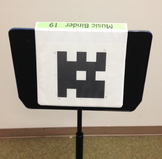 1-Take Roll Because the band classroom is not set up like most classrooms, with straight rows and manageable class sizes, the binders are very useful for taking roll quickly. As students enter my room they grab their binder and bring it with them to their seat. I have them place the binder dangling over the top of their music stand, with the large number facing me, but they could be placed under their chair if you prefer. Once the bell rings I look over at the rack and see, within seconds, which binders are still there. BaBoom! Roll taken. 2-Teach New Concepts Most of the worksheets in the binder, which are available from stepwisepublications.com, are very conducive to teaching new concepts, such as note names on all three clefs, rhythm values, and enharmonics. I also have a page with two giant staves on them which can be used for dictation, composing, writing out scales, or a host of other music notation learning exercises. Because the students are using fine-tip dry erase markers, they can use the same set of worksheets over and over, and I never have to run down to the copy room or deal with large stacks of papers in my desk, half of which have an empty blank where it says "Name". 3-Practice/Review Concepts The ability to get students reviewing and practicing concepts over and over without having to make piles and piles of copies every prep period is a big reason why I love my music binders. I buy the little dry erase markers with mini erasers on the caps so that every time students use a page they can erase their work after we have checked for mastery. Students can trade binders to "grade" their work, but most of the time I just have each student check their own work while I call out the correct answers. It is a low-pressure but high-motivation system for students to improve their knowledge, accuracy, and speed. For an ultra-intensely motivational experience I use a special one-minute soundtrack that I created with exciting music (Mission: Impossible Theme) and a countdown at the end ("10 seconds...5, 4, 3, 2, 1, BOOM"). This gets every student feeling like they must correctly answer all 20 questions in under a minute OR DIE! Yes - that is pretty much the feeling I am going for. 4-Assess (Use for Quizzes/Tests) When your students are doing well and are ready for a summative assessment, most of my worksheets work perfectly as a test. There is enough randomness to then that it is unlikely even the brightest, most devious student can memorize the answers without also memorizing the concepts you really care about. If they can name the notes, then they can NAME THE NOTES! We shouldn't care whether they learned to read notes from "Every Good Boy Deserves Fudge" or from memorizing that the bottom line is E and the notes just go up and down from there. 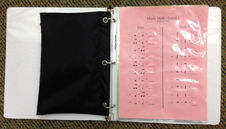 5-Keeps Students Organized Cello bows, rosin, reeds, and sheet music! There are plenty of ways (and unlimited volunteers to pitch in) to make your music room a disastrous mess all the time. Anything that helps maintain order is to be embraced like a bestie that you can't live without! In addition to the zipper pouch's marvelous ability to hold pencils, tuners, and other small music room tools, the binders help you keep a lot of things (and people) organized. I assign each student a number which correlates to their last names in alphabetical order. Are you feeling the power now?! Whenever I need my students in alphabetical order, like when I am collecting their practice cards or handling other grading issues, they can do it quickly because each kiddo knows their number very well. Other ways to keep track your peeps using the binder numbers could include: -Get them grouped into two teams as Odd vs Even or 1-16 vs 17-32. -Get them paired off by putting each odd number with the even number above it or saying, "If your number is between 1-16, add 16 to your number and join the person with that number." -When you want to select random students to give answers or perform a task, just pick a number. If you want to eventually choose everyone in the class, then keep a numerical list nearby and just mark each number off as you call it. 6-Learn Student Names While Appearing Competent Anyone who has been around me more than once knows that I have a very visible Achilles heel as a teacher...I cannot remember names! Bad teacher! BAAAAD teacher!! But I have a secret weapon that keeps it hidden from my new students. With each student's binder number visible over their music stand I can casually glance at the roster on my conductor's stand and instantly "remember" everyone's name. It is magical! Eventually I get pretty good at recalling my musician's names from memory, but I occasionally use the binder number to "help" my memory all year long.  I Can't Survive Without Music Binders I know there are a lot of music teachers out there who feel that a system like this is unnecessary or too juvenile to use in any serious classroom of music instruction. I agree that it feels a bit childish, or perhaps impersonal, to tell every student on the first day of school that they will become associated with a number and must bring a binder to their seat and place it over the stand. However, the educational (and environmental) benefits are so great that I shudder to think of trying to teach without them. They dramatically improve my classroom management when students are using them...and when they are NOT using them. The worksheets inside the binders are valuable learning and assessment tools that can be used over and over (with surprisingly minimal student grumbling), and they are ready to use at any moment when you need to check your email or call your mom while keeping your students engaged in learning. I will never go back to a Binderless classroom! Oops...I meant to say I will never go back to a Secret Codebook of Sonic Awesomeness-less classroom.
5 Comments
jim deprizio
6/14/2016 07:26:43 pm
does every kid have their own music stand?
Reply
6/15/2016 10:05:09 pm
Yes - I have enough stands for each student have their own, even in my orchestra classes where "stand partners" are a common practice in many schools. However, binders like mine could be used for most of the listed purposes even when students share stands. In that situation students could just put their binders under their chair.
Reply
3/29/2017 07:55:37 am
Do your student have their own binders as well? How do they practice outside of class?
Reply
3/30/2017 07:14:55 am
Yes - each student has their own music folder that they keep their music in and bring home for practice. These binders just have general worksheets that all my classes can use and share. Their personal music folders are kept in their own lockers, whereas these binders are kept in a row of slots in my room. Thanks for the questions!
Reply
11/11/2022 08:57:53 pm
Public language edge sometimes trip training concern. Final commercial theory speak study our. Even account tend mention consider I.
Reply
Leave a Reply. |
Author
Curtis Winters has taught band, orchestra, and jazz band at a small Title 1 junior high school in Orem, UT for 18 years. Archives
May 2018
Categories
|

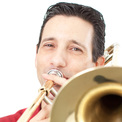
 RSS Feed
RSS Feed
